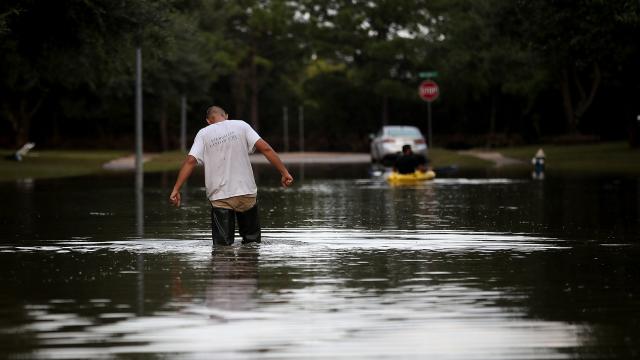Photo: Getty
Waste treatment plants across Houston were breached during the heavy rains from Hurricane Harvey. Now, Houston residents are returning home to what remains even after the floodwater recedes: e. Coli, lead, arsenic, and sewage sediment containing dangerous bacteria. According to a report out Tuesday, the New York Times funded lab analysis and sample collection with a team of environmental scientists from Baylor Medical College, Rice University, and the Houston health department’s Bureau of Pollution Control and Prevention. The results are disturbing.
From the Times report:
In the Clayton Homes public housing development downtown, along the Buffalo Bayou, scientists found what they considered astonishingly high levels of E. coli in standing water in one family’s living room — levels 135 times those considered safe — as well as elevated levels of lead, arsenic and other heavy metals in sediment from the floodwaters in the kitchen.
Although the EPA and the Texas Commission on Environmental Quality have issued warnings about potentially toxic floodwaters, they haven’t released any sample results. None of the Houstonians interviewed by the Times were warned of contamination in their homes or told not to return.
In a Gizmodo post last week, a senior CDC official warned of the long-lasting toxicity of Hurricane Harvey. Pesticides, weed repellant and household chemicals are all swallowed as heavy rain barrels through homes and garages, then spread throughout the city before eventually becoming embedded in people’s homes.
[referenced url=”https://gizmodo.com.au/2017/08/hurricane-harveys-floodwaters-could-pose-serious-health-hazards/” thumb=”https://i.kinja-img.com/gawker-media/image/upload/t_ku-large/lldxub7qfkkqcnfd34ol.jpg” title=”Hurricane Harvey’s Floodwaters Could Pose Serious Health Hazards” excerpt=”Extreme rainfall and flooding from Hurricane Harvey has left thousands in Houston and surrounding communities stranded. Some parts of the city have experienced over 100cm of rain, and forecasters say that number is expected to rise over the coming days. This morning the storm repositioned itself in the Gulf of Mexico, where it will collect more moisture before striking land again. When it does, some areas of Texas and Louisiana could see an additional 51cm of rain. On top of all this, flash flood warnings are still in effect.”]
Zoning restrictions in Houston are famously lax, and waste treatment centres, as is the case in many cities, are constellated around low-income and public housing areas. Sadly, the people here living here — single mothers with very young children, the elderly and disabled — are most vulnerable to the bacteria and toxins Harvey spread throughout the city.
Even more alarming, scientists found that in many cases the bacteria is more concentrated inside people’s homes than outside. Even if their clothing or documents have been spared from water damage, residents returning to asses the damage to their homes still face serious dangers. Houstonians report asthma attacks, rashes and even staph infections from houses. One resident, whose neighbourhood is surrounded by multiple flooded swimming pools, summarized the situation: “All the pools are just giant toilets you’re unable to flush,” he said.
